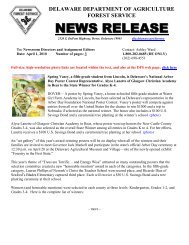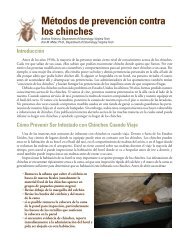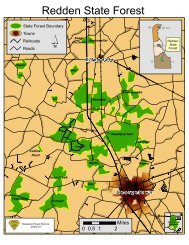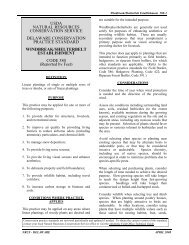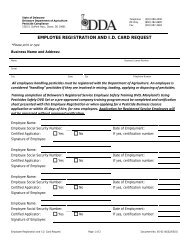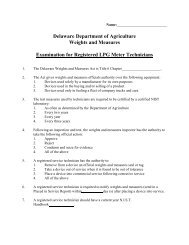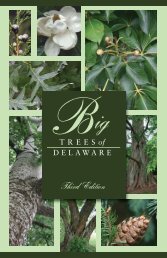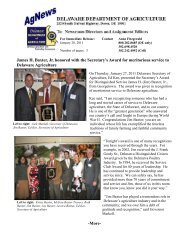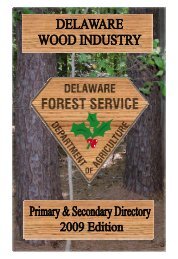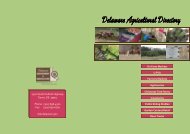DFS Resource Assessment - Delaware Department of Agriculture
DFS Resource Assessment - Delaware Department of Agriculture
DFS Resource Assessment - Delaware Department of Agriculture
You also want an ePaper? Increase the reach of your titles
YUMPU automatically turns print PDFs into web optimized ePapers that Google loves.
Summary – Criterion 1.<br />
While <strong>Delaware</strong> has more forested acres now than a<br />
century ago, forested acres are currently declining. Much<br />
<strong>of</strong> this recent loss is due to dramatic human population<br />
increases in <strong>Delaware</strong>, which has also produced further<br />
forest fragmentation and parcelization. <strong>Delaware</strong> has<br />
taken steps to protect its forestlands – approximately 27<br />
percent (100,000 acres) <strong>of</strong> its 371,000 acres <strong>of</strong> forestland<br />
are now protected through either public ownership or<br />
permanent conservation easements. Nonetheless,<br />
substantially more acres must be protected to ensure<br />
future generations that there is a sufficient forested base to<br />
sustain the many services and benefits <strong>Delaware</strong>ans<br />
currently enjoy.<br />
Likewise, we must ensure that there is a mixture <strong>of</strong> forest<br />
types. <strong>Delaware</strong> experienced significant declines in<br />
loblolly pine in the late 20th century and a slow but steady<br />
increase in the amount <strong>of</strong> older and larger timber. These<br />
trends are not catastrophic but should be addressed to<br />
maintain a balance <strong>of</strong> species composition as well as age<br />
and size composition. This balance is necessary to ensure<br />
that sufficient habitat is provided for the animal and plant<br />
species that require a wide diversity <strong>of</strong> forest habitat and<br />
cover, including threatened species and species <strong>of</strong><br />
concern. An estimated 37 percent <strong>of</strong> forest-dependent<br />
plants and animals are species <strong>of</strong> concern.<br />
federally listed by the U.S. Fish and Wildlife Service –<br />
swamp pink (Threatened, Helonias bullata) and small<br />
whorled pogonia (Threatened, Isotria medeoloides).<br />
Although <strong>Delaware</strong>’s state endangered species law does<br />
not include plants, the <strong>Delaware</strong> Natural Heritage and<br />
Endangered Species Program maintains a list <strong>of</strong> the state’s<br />
rare plant species. Approximately 36 percent (163 species)<br />
<strong>of</strong> all native forest interior plants within the state are rare<br />
with the greatest number (57 percent) occurring within<br />
upland forests. The primary cause <strong>of</strong> decline is loss <strong>of</strong><br />
habitat including wetlands and upland forests.<br />
Maintaining not only a critical mass <strong>of</strong> forestland but also<br />
the wide range <strong>of</strong> forest types is vital for <strong>Delaware</strong> and<br />
ties directly to two <strong>of</strong> the State and Private Forestry<br />
(S&PF) national priorities – Conserve and Manage<br />
Working Forest Landscapes for Multiple Values and Uses<br />
and Enhance Public Benefits from Trees and Forests.<br />
Conclusions: None <strong>of</strong> <strong>Delaware</strong>’s tree species are<br />
federally endangered or threatened; however, significant<br />
changes have occurred in <strong>Delaware</strong>’s forest types. In<br />
addition to the loss <strong>of</strong> loblolly pine forests, there has been<br />
a significant disappearance <strong>of</strong> baldcypress and Atlantic<br />
white-cedar. Additionally, while there are only two<br />
federally listed endangered animal and plant species in<br />
<strong>Delaware</strong> – both forest dependent – there are a number <strong>of</strong><br />
state species <strong>of</strong> concern that require forest habitat and<br />
further loss <strong>of</strong> forested habitat will place more species at<br />
risk. Forest management standards should be structured to<br />
protect critical wildlife habitat.<br />
16 <strong>Delaware</strong> Forest <strong>Resource</strong> <strong>Assessment</strong>



